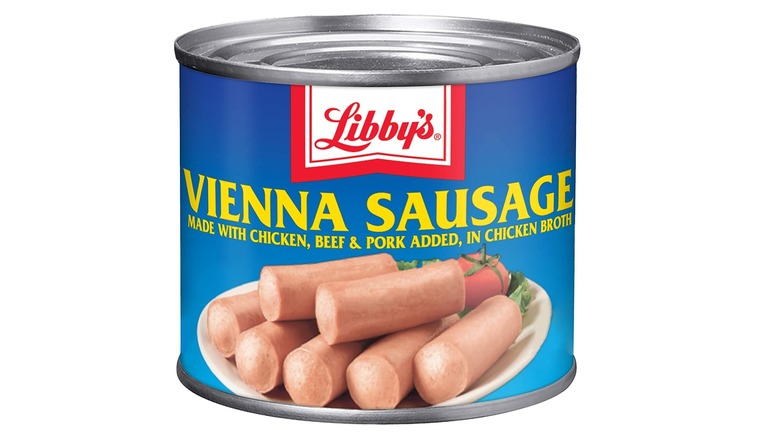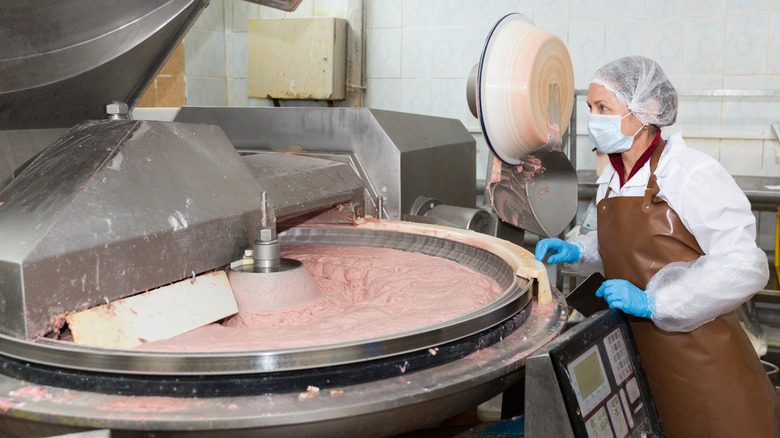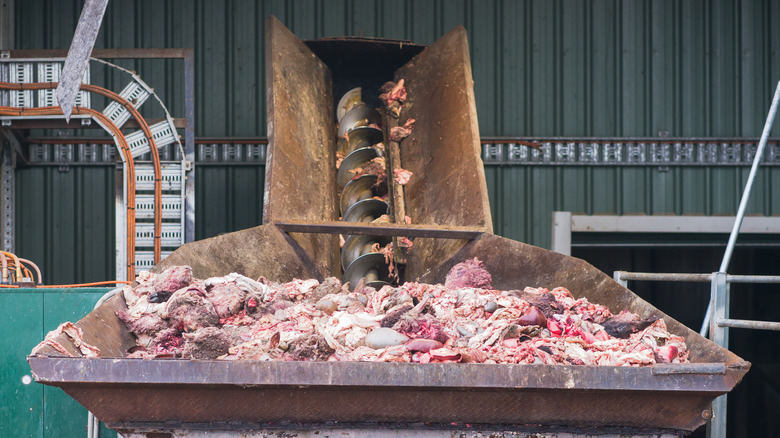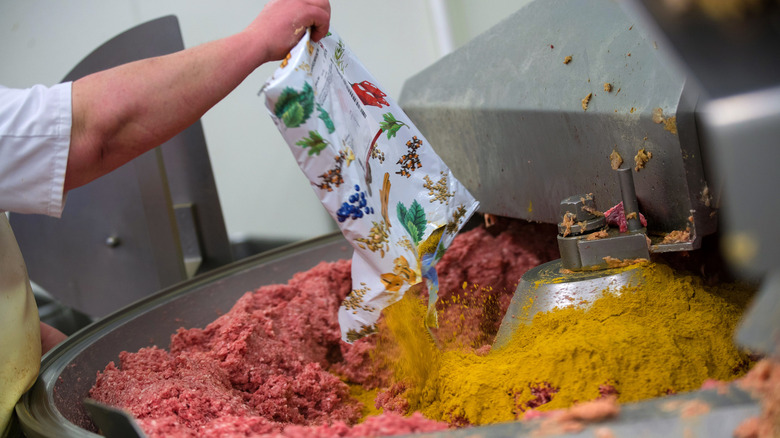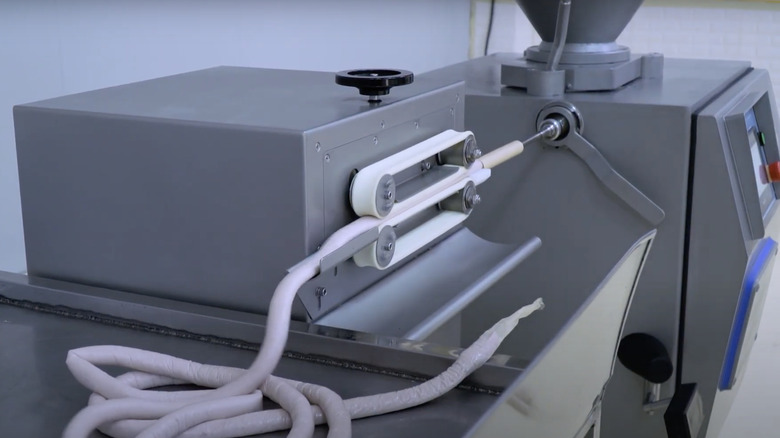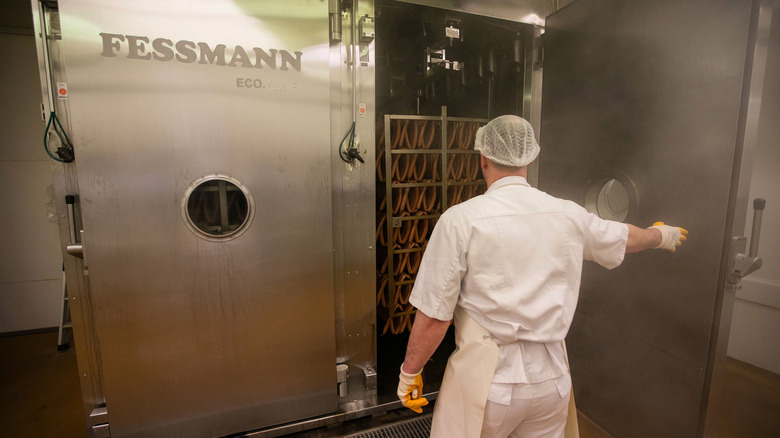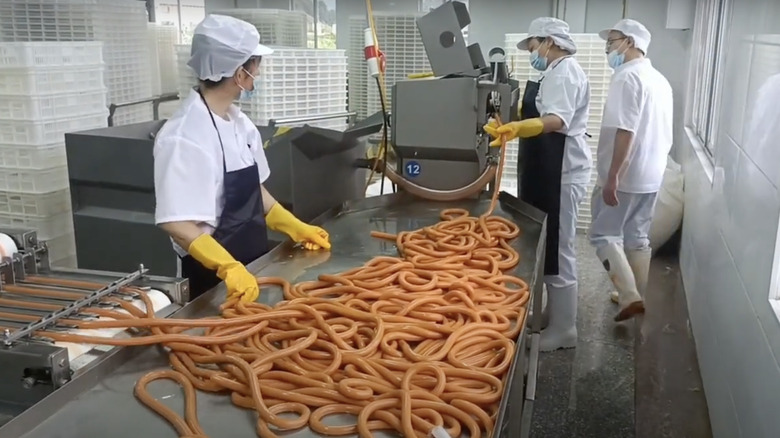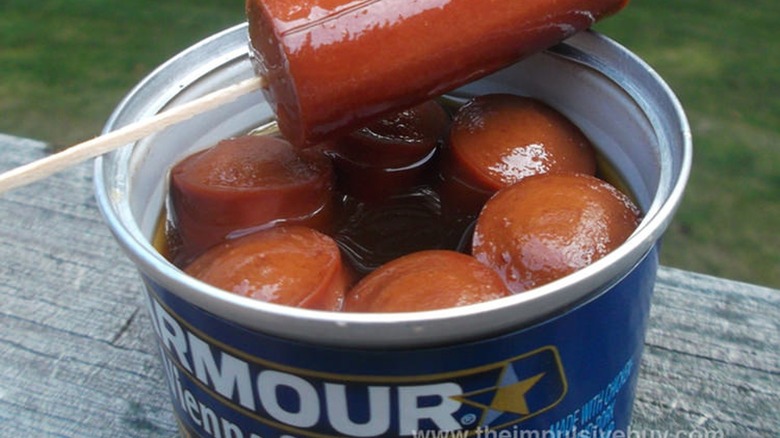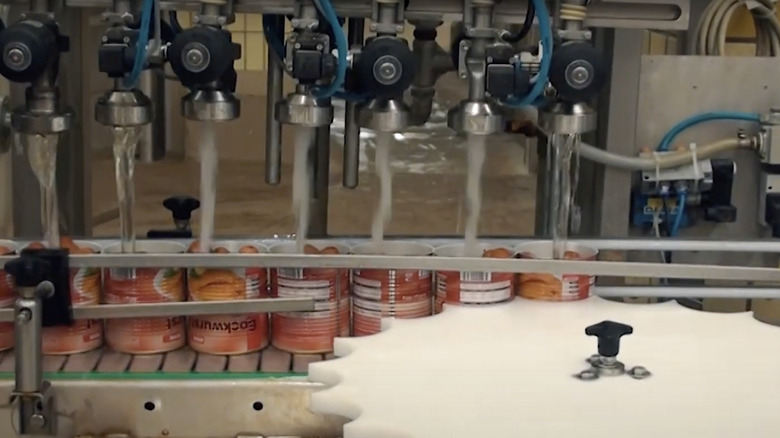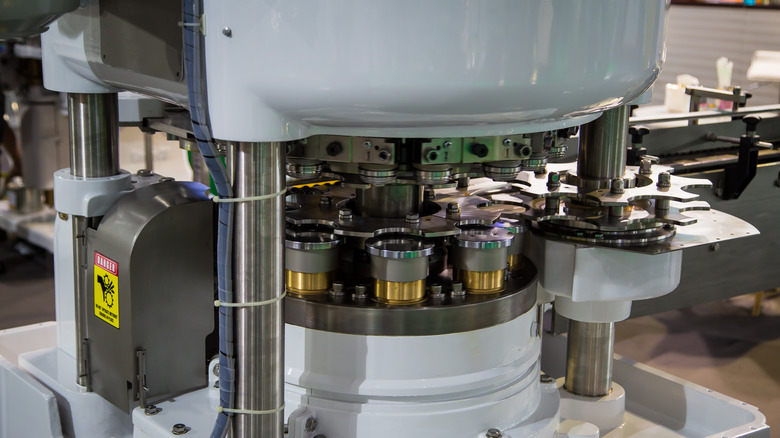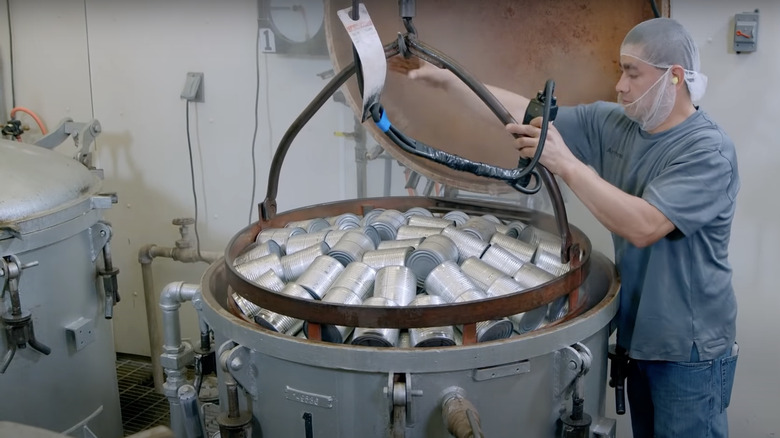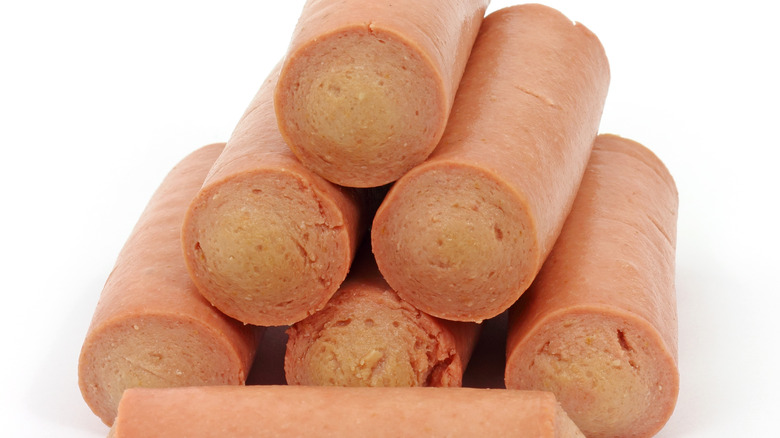Here Is How Vienna Sausages Are Really Made
We may receive a commission on purchases made from links.
You've taken a can of the stuff camping or on a road trip, but you've never wondered how factories made Vienna sausage until now. It's fascinating and complex — Vienna sausages are the apex of thousands of years of learning to preserve food combined with the marvels of modern industrial engineering. Generations of trial and error have given humankind this can of meat.
First, there's sausage, likely invented by hunters, hoping to preserve and transport every scrap they could. They stuffed small, meaty leftovers from butchering into the easiest available containers they had — the stomach and intestines. Skinless Vienna sausage probably tastes far better than this predecessor, although it still uses scraps, but from meat packing plants rather than hunting sites.
Then, there's the can. Before canned food, travelers had to rely on dried wares and fresh food they might or might not find at their destinations. Then, in 1809, Nicolas Appert responded to the French army's call for a better solution. His research gave them canned food. The days of pillaging ended, and the navy could sail farther and wider. More importantly, people could now preserve sausages in cans, and the raging industrial revolution would drive them to do so at a massive scale, giving the world the Vienna sausage we know and love today. Now, take a peek inside those industrial plants to see what ingredients go inside these two-inch sausages and how they get in the can.
Vienna sausages contain chicken, beef, and pork
The process of making Vienna sausages starts with a huge funnel leading down into an industrial meat grinder. That's where workers dump heaping bins of meat trimmings from chicken, beef, and pork. Most Vienna sausages contain these three types of meats, making them similar to hot dogs.
Meat trimmings are exactly what they sound like. When meatpackers prepare steaks and chops, they have to cut off uneven and fatty pieces of meat — trimmings. These irregularly shaped bits would be difficult to sell directly to consumers, so they freeze them into blocks and ship them to factories. There's a limit on the amount of animal fat that they can include because the U.S. Department of Agriculture (USDA) requires that sausages contain no more than 30% fat.
The best way to know what type of meat is in your sausage is to read the ingredients label on the back of the can since the recipes at different plants can vary. Some Vienna sausages contain only chicken, and companies label them as such. Most others contain a high percentage of chicken and less beef and pork. Vienna sausage wasn't always like this. A patent from the 1960s described the recipe for Vienna sausage as 25 pounds of beef chuck, 25 pounds of beef plate trimmings, and 50 pounds of regular pork trimmings — no chicken necessary.
Are there animal byproducts or meat slime in Vienna sausages?
The chatter around Vienna sausage says it includes distasteful ingredients — organs like the heart, liver, and kidneys or, worse, infamous pink slime. Who knows what goes into those industrial meat grinders?
Fortunately, the USDA has strict rules about the way companies label the ingredients in sausage, and the agency's Food Safety Inspection Service ensures manufacturers comply. This means that Vienna sausage makers have to clarify the contents on the ingredients list.
If a Vienna sausage can's label says it contains byproducts or variety meats, it means heart, liver, or kidney. Flip the can over, and the ingredients have to say which species of animal these came from and what they are.
You'll never see the words pink slime on a label, though. That's because it's another way to say mechanically separated meat. Machines produce this ingredient by forcing meat and bones through a sieve under high pressure, creating a pink, slimy puree. The USDA prohibits the use of mechanically separated beef in human food, but mechanically separated pork is acceptable. Companies must label it as what it is, though, and sausages can't contain more than 20% mechanically separated meat. On the other hand, they can include any amount of mechanically separated poultry they want. Both have to appear on the ingredients list as mechanically separated, though. Grab a can of Libby's or Armour Vienna sausage, and you'll see the first ingredient is indeed mechanically separated chicken.
What other ingredients get mixed into Vienna sausage?
After grinding meat trimmings and mechanically separated chicken into a thick goo, factory workers start pouring additional ingredients into the batter. Adding water or ice smooths out the mix and helps make everything more homogenous. It serves a second purpose as well — keeping it cool. All that grinding can heat the mix. If the batter gets too hot, it'll cook prematurely so ice is extra handy. There's a limit to this, though. The USDA says cooked sausages can only contain up to 10% water.
High water content poses the problem of shrinkage while cooking, though. That's where starch or binder flour comes in to save the day. This ingredient ensures that the final product will preserve its shape as it cooks.
Workers pour in bags of salt and spices as well. Vienna sausages can contain paprika, onion, garlic, mustard, mace, and coriander to give them their distinctive flavor. Finally and surprisingly, a stream of corn syrup gets poured into the batter. This will make the final sausage sweetly attractive to the taste buds. Machines like huge blenders then puree the batter and vacuum out air pockets to make a smooth emulsion after integrating the various ingredients.
Shaping batter into Vienna sausages
YouTube and TikTok are full of oddly satisfying videos of people performing tasks like cleaning very dirty carpets with pressure washers or using wood-turning equipment. Clips of Vienna sausage batter being filled into casings clearly belong in this same category of media. Here's what you'll see: A funnel directs batter into a machine that uses just the right amount of pressure to push it through a spout. On that spout, there's a tube of casing. A worker makes a knot at the end of the casing, and batter starts flowing into it.
The casing expands as it fills, and rollers pull the hose of sausage steadily along. One length of Vienna sausage, before cutting, can measure 80 feet — that's a little longer than a tennis court. In the most advanced facilities, machinery automatically loops the sausage onto hooks. In other plants, it's spread on a stainless steel surface until workers hang it on racks to wheel it to the smoker.
You may be wondering about the casing since you've never seen it in a can of Vienna sausages. All sausage cooks in membranes, but there are different kinds — edible collagen and inedible cellulose. Factories use cellulose casing to make Vienna sausage. It's porous so the flavor of liquid smoke can seep in as it cooks. Since this casing is not edible, though, machinery strips it off before packaging — that's why you've never noticed it.
How do they smoke Vienna sausage?
Hickory smoke flavoring is one of the ingredients listed on barbecue flavored Armour Vienna sausage. In some cases, workers mix artificial smoke into the batter, but there's a better way to give sausage that distinctive taste, and it's not by using wood smoke.
In 1983, Robert R. Hershfeld of the Baltimore Spice Company applied for a patent under the title, "Apparatus for shower applying liquid smoke." Smoking, he says, is a particularly important step in making skinless products like hot dogs or Vienna sausage. The reaction of the smoke particles with the protein in the meat causes a sort of coagulation on the surface that holds the wiener together after stripping the casing. Previous to his invention — a shower that recirculates liquid smoke over a constant flow of sausage — manufacturing plants had to wait around 25 minutes after each batch of sausage since they used liquid smoke mists. Using Hershfeld's machine, the production line never needs to stop.
After the drenching of liquid smoke, the sausage moves along to an oven where it bakes. Then, when it comes out of the oven, the product gets another shower. This time cold, salty water pours over the steaming meat to cool it quickly for packaging. Factories lines have to move fast to make quotas — Armour brand alone sells about 200 million cans in a year.
Removing the casing from Vienna sausages
Shape is one of the characteristics that makes this food distinctive — Vienna sausage doesn't have tied-off ends like hot dogs or cocktail sausages. This is because machinery cuts the sausage into two-inch lengths, just the right size to fit in the can. Before that happens, though, the casing needs to come off, and that involves a sausage peeler.
The sausage peeler must be the most fun machine in the whole factory. It uses a tiny knife to cut the casing, steam then blows it off, and a vacuum sucks up the disposable cellulose. To prevent mistakes, the casing often comes with a dark stripe to make it more evident whether sausage has been peeled or not. What makes the machine it so entertaining, though, is how it shoots sausage out. In the case of Vienna sausage, it looks like lengthy pink hoses bursting out.
Next, workers feed those pink hoses of meat into an apparatus that will chop them into perfect little Vienna sausages. Such a machine has only existed since 1955 when the patent office granted an application from Bernard T. Hensgen of Swift and Co. His machine not only cut the sausage to fit the can, but then turned the metal container as well, preparing it for sealing. Hensgen gave Vienna sausage the shape we know today.
Machines load Vienna sausages into cans
A USDA manual from 1911 describes how plants used to get the Vienna sausages in the can. This repetitive labor fell to women who manually stuffed individual sausages in the cans. If that doesn't sound sanitary, don't worry — factories regularly employed manicurists to ensure that the workers' hands were clean.
For about 40 years this step of packaging Vienna sausage was a source of employment, but then machines took over. The apparatus described by Bernard Hensgen's 1955 patent meant that these can stuffers were laid off or placed at other work stations. Now, a single piece of equipment could cleanly slice long sausages into uniform lengths and load them vertically into cans. His invention wasn't the first of its kind, but previous machinery harmed the sausage while slicing and got gummy from the bits that stuck to it. This new piece of equipment was an improvement.
Today, similar machines continue to swiftly cut, count, and group sausages into up to 400 cans per minute. Most often a can of Vienna sausage comes with seven pieces, but these loaders also allow plants to adjust to lower numbers if necessary. Could that be a sign of the dreaded shrinkflation?
Broth or sauce covers Vienna sausages
Sausage-filled cans travel along a conveyor and stop under nozzles. Liquid shoots out, filling the cans in less than a second. Then, they zip away to their next stop. The type of packing liquid depends on the variety of Vienna sausage. If it's the original flavor, the liquid is chicken broth. Armour's Hot and Spicy flavor replaces broth with tomato puree, hot sauce, and vinegar. The barbecue variety contains water, tomato paste, vinegar, smoke flavor, and Worcestershire sauce.
This liquid filling for each of the flavors has been carefully designed to preserve the sausages, but that wasn't always the case. In 1961, Ralph Triller and Virgil Rupp of Hygrade Food Products turned in a patent application, "Product for packing Vienna sausages." Within it, they describe a problem: The fluid in Vienna sausage cans — usually water or brine — was leaching the protein and seasoning from the little wieners. The longer the sausages were in the can, the more severe the loss of taste and quality. They weren't the first to notice – in 1938, the Bryan Packing Company of Mississippi had started packing the treats in oil, although today, like Armour and Libby, the company uses broth. Triller and Rupp proposed a healthier alternative. They suggested filling cans with broth that had similar attributes to Vienna sausage itself to preserve and add flavor. This practice became commonplace, and now the idea of Vienna sausage without the thick, gooey liquid is unimaginable.
They seal the cans of Vienna sausage
Seamers are the machines that seal cans of Vienna sausage. They look like giant wheels with can-sized holes around the edge. Depending on the dimension of the cans and the machine, there could be anywhere from four to eight of these slots. They rotate cans through each step of the process — the first hole grabs the can, the second places the lid, the third seals it, and the last hole pushes the product back onto the conveyor belt again. That third step is complex, though — it involves two rollers, touching the edge of the can and lid to curl them together into just the right shape to make it airtight. It's called double seaming. In just one minute, this apparatus can process 300 to 600 cans of Vienna sausage.
Once the cans are back on the line again, water sprays over them to ensure that they're clean before loading them into enormous baskets or racks. These containers will ferry the cans to a pressure canner.
They process cans in a pressure cooker
If you wanted to can Vienna sausage at home, you would need to put your jars in a pressure canner for between 75 and 90 minutes to prevent spoilage. Plants that produce canned Vienna sausage have to do the same, but specialized machinery, called retorts, does it much more quickly.
Retorts can come in different shapes and sizes. The smallest ones look like giant pressure cookers — about a yard and a half wide and come up to workers' chests. They have a manual lid that opens and shuts at the top. Workers use small cranes to lift huge baskets of cans and put them inside. The biggest Vienna sausage factories, like Armour or Libby, have boxcar-sized retorts that take several can-filled racks and process them all at once. These come complete with a conveyor belt to load them and doors that automatically open and shut.
After coming out of the retort, cans cool and then go through a labeling machine. They also go through a series of quality controls — for example, weight check and X-ray for bones or other foreign objects. Digital imaging equipment verifies that seals are true. It's a high-tech process from start to finish.
Problems at the Vienna sausage plant
Even with the fabulous machines and fantastic technology that companies use to make Vienna sausages, sometimes things go wrong, and in plants that produce hundreds of cans a minute, that can come out to a huge loss. For example, in February 2023, Conagra Brands recalled nearly 2.6 million pounds of Vienna sausage — all of the sausage its plant produced between December 12 and January 13. Workers noticed leaking cans in warehouses and reported the problem. Something had gone wrong, and the cans got damaged during the sealing process. Fortunately, they caught the mistake before anyone ate the product and got sick.
There are so many precise steps that could have caused the issue. Maybe the cans were slightly dented from the very beginning. Perhaps the rollers on the can seamer got bent out of shape. It's even possible that someone put the retort temperature or timer on the wrong setting. Whatever it was, this error is responsible for millions of pounds of food waste and likely cost Conagra a huge amount of money, not to mention the public's loss of faith in Vienna sausage. There are huge benefits to mass manufacturing, but this experience has highlighted one of the main disadvantages.
